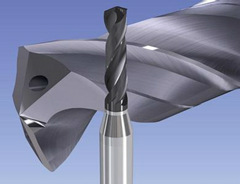 Cemented carbide, also called hard-metal, is the most important usage for tungsten, and its main component is tungsten carbide (WC) whose hardness is only slightly lower than diamond. As cemented carbides combine the great hardness and strength of tungsten carbide with the toughness and plasticity of a metallic alloy binder, such as Co, Ni or Fe, they are widely used to manufacture cutting and mining products, such as drill bits, high speed cutting tools, lathe tools and milling cutters.
Cemented carbide, also called hard-metal, is the most important usage for tungsten, and its main component is tungsten carbide (WC) whose hardness is only slightly lower than diamond. As cemented carbides combine the great hardness and strength of tungsten carbide with the toughness and plasticity of a metallic alloy binder, such as Co, Ni or Fe, they are widely used to manufacture cutting and mining products, such as drill bits, high speed cutting tools, lathe tools and milling cutters.
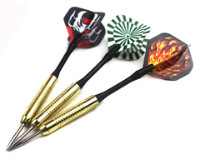 Tungsten can be used as a pure metal or mixed with other metals to make alloys. Because tungsten alloys tend to be strong and flexible, resist wear and corrosion, and conduct electricity well, they are used in different applications, for example, tungsten-steel alloys are used in the production of rocket engine nozzles, which must have good heat resistant properties, super-alloys containing tungsten are used in turbine blades and wear-resistant parts and coatings, while high-density alloys of tungsten with nickel, copper or iron are used in high-quality darts.
Tungsten can be used as a pure metal or mixed with other metals to make alloys. Because tungsten alloys tend to be strong and flexible, resist wear and corrosion, and conduct electricity well, they are used in different applications, for example, tungsten-steel alloys are used in the production of rocket engine nozzles, which must have good heat resistant properties, super-alloys containing tungsten are used in turbine blades and wear-resistant parts and coatings, while high-density alloys of tungsten with nickel, copper or iron are used in high-quality darts.
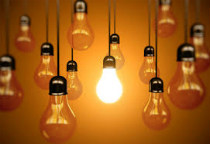 Tungsten has a high melting point and low vapor pressure, so it is used in many high-temperature applications, such as light bulbs, cathode-ray tubes and vacuum tube filaments.
Tungsten has a high melting point and low vapor pressure, so it is used in many high-temperature applications, such as light bulbs, cathode-ray tubes and vacuum tube filaments.- Because tungsten has conductive properties and relative chemical inertness, it is also used in electrodes, for instance in electron microscopes.
- Tungsten's tolerance to intense heat also makes it an ideal material in electronics. For example, tungsten is used as an interconnect material in integrated circuits, between the silicon dioxide dielectric material and transistors. Tungsten is also one of the main sources for X-ray targets due to its electronic structure.
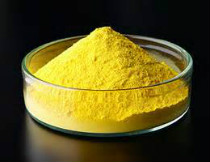 Tungsten chemicals are used in the form of tungsten oxides, tungstates, tungstic acid, silicotungstic acid, phosphotungstic acid or tungsten sulfides. These chemicals are used in the oil, lubricants, mining, electronics and medical industries, etc, for example, tungsten sulfide is a high-temperature lubricant and also a component of catalysts for hydrodesulfurization, and tungsten oxide is incorporated into selective catalytic reduction (SCR) catalysts by coal-fired power plants.
Tungsten chemicals are used in the form of tungsten oxides, tungstates, tungstic acid, silicotungstic acid, phosphotungstic acid or tungsten sulfides. These chemicals are used in the oil, lubricants, mining, electronics and medical industries, etc, for example, tungsten sulfide is a high-temperature lubricant and also a component of catalysts for hydrodesulfurization, and tungsten oxide is incorporated into selective catalytic reduction (SCR) catalysts by coal-fired power plants.
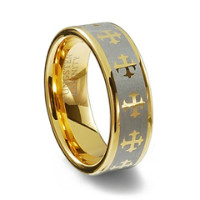 Besides the applications mentioned above, tungsten has many other uses. Tungsten's thermal expansion is similar to borosilicate glass, thus it is used to make glass-to-metal seals. Tungsten is also used in jewelry as a gold or platinum substitute because its density is similar to gold.
Besides the applications mentioned above, tungsten has many other uses. Tungsten's thermal expansion is similar to borosilicate glass, thus it is used to make glass-to-metal seals. Tungsten is also used in jewelry as a gold or platinum substitute because its density is similar to gold.- Because tungsten oxides have two unique properties—intercalation and polycondensation—there is a great opportunity for tungsten to be used in fuel cell or energy-saving technologies in the future.
-
About us
Contact us
Make a suggestion
- Metalpedia is a non-profit website, aiming to broaden metal knowledge and provide extensive reference database to users. It provides users reliable information and knowledge to the greatest extent. If there is any copyright violation, please notify us through our contact details to delete such infringement content promptly.
 Cemented carbide, also called hard-metal, is the most important usage for tungsten, and its main component is tungsten carbide (WC) whose hardness is only slightly lower than diamond. As cemented carbides combine the great hardness and strength of tungsten carbide with the toughness and plasticity of a metallic alloy binder, such as Co, Ni or Fe, they are widely used to manufacture cutting and mining products, such as drill bits, high speed cutting tools, lathe tools and milling cutters.
Cemented carbide, also called hard-metal, is the most important usage for tungsten, and its main component is tungsten carbide (WC) whose hardness is only slightly lower than diamond. As cemented carbides combine the great hardness and strength of tungsten carbide with the toughness and plasticity of a metallic alloy binder, such as Co, Ni or Fe, they are widely used to manufacture cutting and mining products, such as drill bits, high speed cutting tools, lathe tools and milling cutters. Tungsten can be used as a pure metal or mixed with other metals to make alloys. Because tungsten alloys tend to be strong and flexible, resist wear and corrosion, and conduct electricity well, they are used in different applications, for example, tungsten-steel alloys are used in the production of rocket engine nozzles, which must have good heat resistant properties, super-alloys containing tungsten are used in turbine blades and wear-resistant parts and coatings, while high-density alloys of tungsten with nickel, copper or iron are used in high-quality darts.
Tungsten can be used as a pure metal or mixed with other metals to make alloys. Because tungsten alloys tend to be strong and flexible, resist wear and corrosion, and conduct electricity well, they are used in different applications, for example, tungsten-steel alloys are used in the production of rocket engine nozzles, which must have good heat resistant properties, super-alloys containing tungsten are used in turbine blades and wear-resistant parts and coatings, while high-density alloys of tungsten with nickel, copper or iron are used in high-quality darts. Tungsten has a high melting point and low vapor pressure, so it is used in many high-temperature applications, such as light bulbs, cathode-ray tubes and vacuum tube filaments.
Tungsten has a high melting point and low vapor pressure, so it is used in many high-temperature applications, such as light bulbs, cathode-ray tubes and vacuum tube filaments. Tungsten chemicals are used in the form of tungsten oxides, tungstates, tungstic acid, silicotungstic acid, phosphotungstic acid or tungsten sulfides. These chemicals are used in the oil, lubricants, mining, electronics and medical industries, etc, for example, tungsten sulfide is a high-temperature lubricant and also a component of catalysts for hydrodesulfurization, and tungsten oxide is incorporated into selective catalytic reduction (SCR) catalysts by coal-fired power plants.
Tungsten chemicals are used in the form of tungsten oxides, tungstates, tungstic acid, silicotungstic acid, phosphotungstic acid or tungsten sulfides. These chemicals are used in the oil, lubricants, mining, electronics and medical industries, etc, for example, tungsten sulfide is a high-temperature lubricant and also a component of catalysts for hydrodesulfurization, and tungsten oxide is incorporated into selective catalytic reduction (SCR) catalysts by coal-fired power plants. Besides the applications mentioned above, tungsten has many other uses. Tungsten's thermal expansion is similar to borosilicate glass, thus it is used to make glass-to-metal seals. Tungsten is also used in jewelry as a gold or platinum substitute because its density is similar to gold.
Besides the applications mentioned above, tungsten has many other uses. Tungsten's thermal expansion is similar to borosilicate glass, thus it is used to make glass-to-metal seals. Tungsten is also used in jewelry as a gold or platinum substitute because its density is similar to gold.